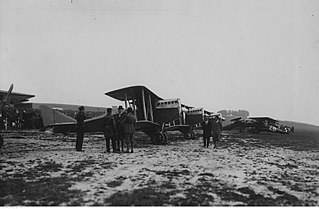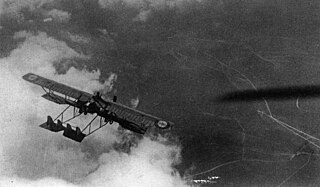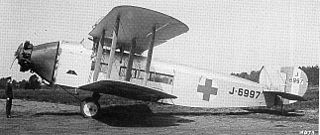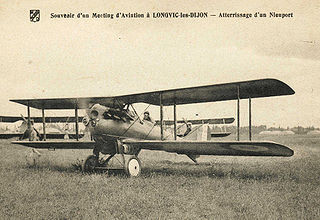
The Vickers Vulcan was a British single-engine biplane airliner of the 1920s built by Vickers Limited at Brooklands Aerodrome, Surrey. It carried eight passengers and a pilot.

The Ansaldo A.300 was an Italian general-purpose biplane aircraft built by the Ansaldo company of Turin from 1920 to 1929. It also served as a light bomber, transport, fighter and reconnaissance aircraft, and finally as an advanced trainer, with examples in service as late as 1940. 50 examples were also license-built in Poland at ZM E. Plage & T. Laśkiewicz, but were not a success due to poor quality.

The Caudron G.3 was a single-engined French biplane built by Caudron, widely used in World War I as a reconnaissance aircraft and trainer.

The Caudron G.4 was a French biplane with twin engines, widely used during World War I as a bomber. It was designed by René and Gaston Caudron as an improvement over their single-engined Caudron G.3. The aircraft employed wing warping for banking. The first G.4 was built in 1915, and it was manufactured in France, England and Italy. It was the world's first twin-engine aircraft to be widely used, starting in March 1915.

Georges Levy G.L. 40 HB2 was a three-seated French, amphibious biplane aircraft that was designed in 1917. The aircraft was designed by Blanchard and Le Pen and therefore the aircraft was also known as the Levy-Le Pen. Le Pen was Maurice Jules-Marie Le Pen born in Lorient, Morbihan, France in 1889; he was killed in a car crash in 1919. It was claimed to be the best French amphibious aircraft of World War I, but that is probably due to the low scale production of such aircraft in France at that time.

The Salmson 2 A.2, was a French biplane reconnaissance aircraft developed and produced by Salmson to a 1916 requirement. Along with the Breguet 14, it was the main reconnaissance aircraft of the French army in 1918 and was also used by American Expeditionary Force aviation units. At the end of the First World War, one-third of French reconnaissance aircraft were Salmson 2s.

The Bristol Pullman was a British prototype passenger aircraft developed from the Braemar triplane heavy bomber.

The Airco DH.16 was a British four-seat commercial biplane of the 1910s designed by Geoffrey de Havilland, the chief designer at Airco.

The BAT F.K.26 was a British single-engined four-passenger biplane transport aircraft produced by British Aerial Transport Company Limited of London at the end of World War I.

The de Havilland DH.18 was a single-engined British biplane transport aircraft of the 1920s built by de Havilland.

The Beneš-Mráz Bibi was a 1930s Czechoslovak two-seat touring aircraft.

The Bristol Ten-seater and Bristol Brandon were British single-engine biplane transport aircraft built by the Bristol Aeroplane Company in the early 1920s. Only three were built, two of which were used as civil transports and one of which served with the Royal Air Force.

The Blériot-SPAD S.20 was a French fighter aircraft developed near the end of World War I. Too late to serve in the war, almost 100 of these aircraft equipped the French Air Force in the years immediately following. These agile aircraft were also used successfully for air racing and record-setting.

The Nieuport-Delage NiD.29 was a French single-seat biplane fighter designed and built by Nieuport-Delage for the French Air Force.

The Morane-Saulnier AR was a trainer aircraft produced in France during and after the First World War. Developed from the Morane-Saulnier LA reconnaissance aircraft, it was a wire-braced parasol-wing monoplane of conventional design with two open cockpits in tandem and cross-axle-style tailskid undercarriage. Construction was mostly of fabric-covered wood, but the forward fuselage was skinned in metal.

The Nieuport-Delage NiD 30 was a French airliner which entered service in 1920. It was a conventional biplane design with an enclosed cabin that seated four passengers and an open cockpit for the pilot. Provision was also made for a wireless transmitter, receiver, and operator. Seven examples were operated by Compagnie générale transaérienne on its Paris–London route on twice-daily return services.

The SIAI S.13 was an Italian 1910s reconnaissance flying-boat.
The Grahame-White Ganymede was a prototype British heavy night bomber intended to serve with the Royal Air Force in the First World War. A large, three-engined, twin-boom biplane, the sole prototype Ganymede did not fly until after the war had ended, and although an attempt was made to convert the aircraft to an airliner, it was unsuccessful.
The Sopwith Antelope was a British three-seat transport aircraft built after the end of the First World War. A single-engined biplane based on the Sopwith Wallaby long-range aircraft, only a single Antelope was built.

The Farman FF 65 Sport was a French built light biplane, with a single engine and tandem seats, intended for sport and touring. First flown in 1919, it achieved modest sales at home and abroad in the early 1920s. Two unusual modifications produced a biplane glider and a low aspect ratio parasol wing machine.




















